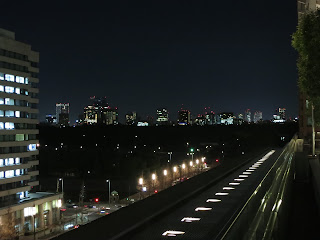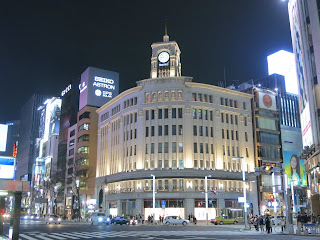The city of Tokyo is sometimes described as the city that never sleeps. Its an apt description because when night falls the city lights come on and everything seems alive with buzzing electricity. There is a human energy to this city long after the rest of the world might go to bed. Businessmen crowd tiny izakaya (bars), karaoke places light up the night with glitzy music, shops close, but their windows gleam with the promise of the next day's wares. Even Karaoke bars try to entice passers by for another moment, just one more song. Indeed, the city doesn't seem to slow down until the very early morning. Before the sun comes up, everything is quiet, still. No one is around, and you can feel that for once you are truly alone in the metropolis.
 |
| Karaoke Bar |
Buildings in Tokyo become canyons made by the hands of man, stand within them and you dont know east from west or north from south. You are simply there, in that place in that moment in time, a stone in a river of people moving through lives that don't involve your own. Its a strange experience, going out at night, and something anyone going to Japan needs to do at least once. In fact, I would challenge my readers: don't hole up in your hotel at night! Go out, tempt that next door building, go inside, 9 chances out of 10 you'll find its loaded with delicious restaurants just begging you to try the food. Better yet, sidle up to a tiny bar or yakkitori (skewered meat/food) joint. Walk by one of these places and smell the delicious aroma and try not to salivate.
Ginza is a glitzy area of high priced shops and incredible wealth. The land here is perhaps some of the most expensive in the world, and many corporations have set up shop. You don't have to be a high roller to have a good time however. Just walk along the streets and you will find such interesting discoveries as the fellow above. This is on the side of the Sony building, displaying the paper lantern style float used in another part of Japan. Normally such a float would be lit from within, giving it a very ethereal quality, but this was an impressive design on its own to see on the side of a building.
Walking down the street, I sometimes paused to glimpse down other ways. Billboards line the sides of buildings, piled one on top of another in weird, jumbled meses. To the Japanese eye it must be easy to read, but for me the sight of these glowing signs was weird and cool all at once. I wondered what lay down that way, could I chance passing by, seeing what was there. I didn't and stuck to my path.
There was more to see above the streetview, huge flashing signs and screens all competing for attention. The sound of cars meshed with people, trains, and sirens. It's a cavalcade to the foreign ear, but even then there are points of quiet.
Walking by one shop, I stopped and stared at the ceiling. It looked as if a crowd of floating paper lanters hung over tables and chairs surrounding stacks of books. This library, or store, whichever it was, glowed fromt he inside as much as it did out. The lanterns alone struck me for their beauty and unearthly quality of light.
There is history to be found in Tokyo, sometimes int he strangest places. The Kabukiza Theater sits just beneath a huge, new skyscraper built on top of it just last year. The structure itself is old Japanese, lit by white light against the white painted walls. The building looks like it's appeared from a different place and time, and sat itself in defiance of the taller structures around it. Inside, Kabuki plays were going on, with posters of stories and actors I wouldn't know or recognize. Just a chance, and I could go in, but not this night.
To those who wonder about my safety, I will say this. Tokyo for all its size is one of the safest cities in Japan, maybe in the world. There are policemen/women all over the place and even in the dead of night I felt perfectly comfortable walking around. People park their bikes without locks all over, and wherever you go you can be sure that there is someone who is willing to help you find your way even if you get lost in translation. Of course, walking with more people ensures more safety, but I would rather walk alone at night through Tokyo than dare go out into Paris after visiting both cities.
Tokyo at night is a place and time removed from our sense of reality. If Tokyo is the city that never sleeps, then it is a waking dream. As dawn approaches, the city lights go out one by one and the stars in the sky fade. All is quiet, solemn and still and even the buzzing of electricity fades. As the sun peeks through the canyons made by men, the light of day reflects off glass and steel. No one is around, and for a moment it seems like Tokyo does indeed sleep. Then, bit by bit, the city wakes, stretches its arms and then the day starts again. Throngs of people pour through the gates of subways, and night becomes forgotten. Its a surreal experience to witness this transformation, but one I think anyone could enjoy.
Next time: Tokyo Skytree















